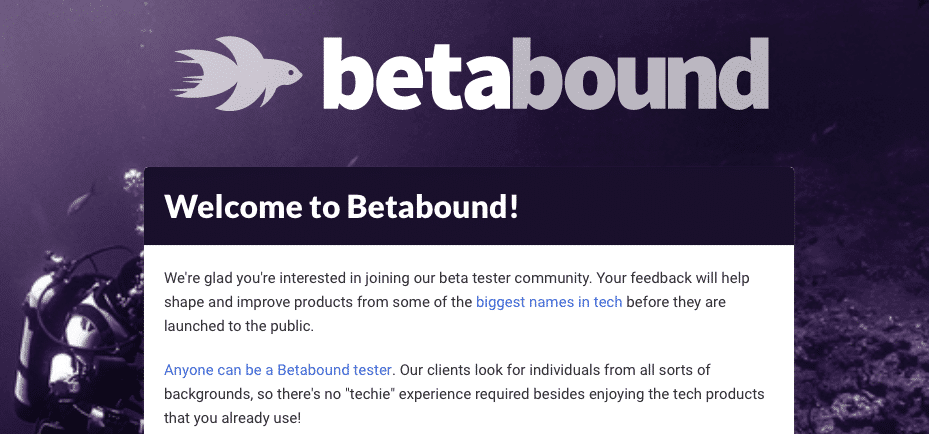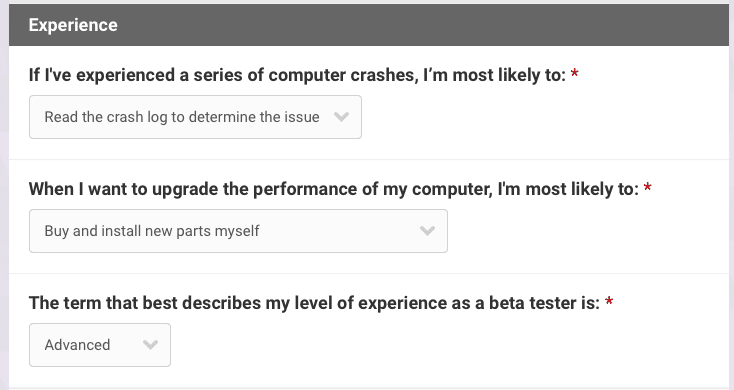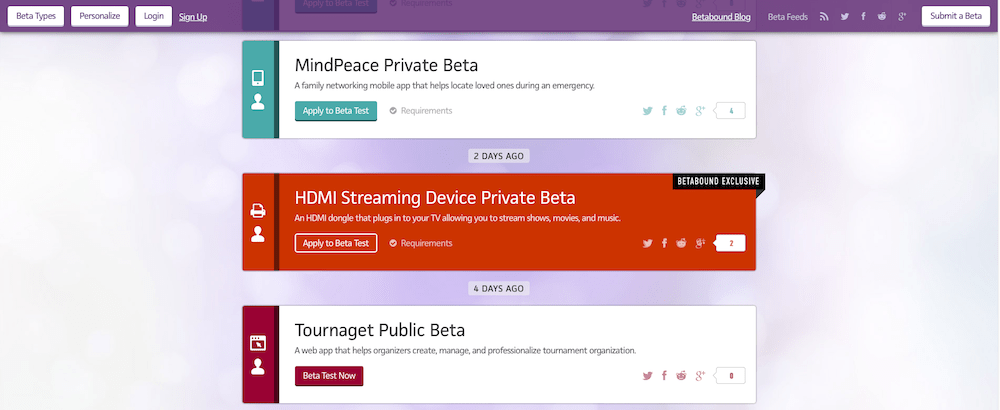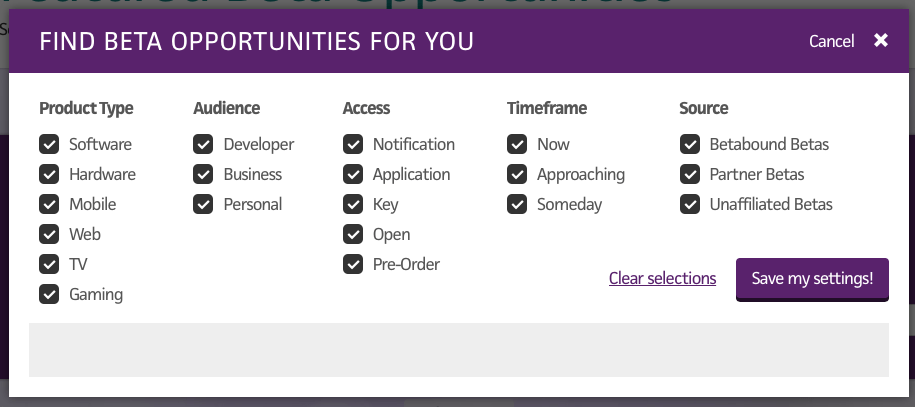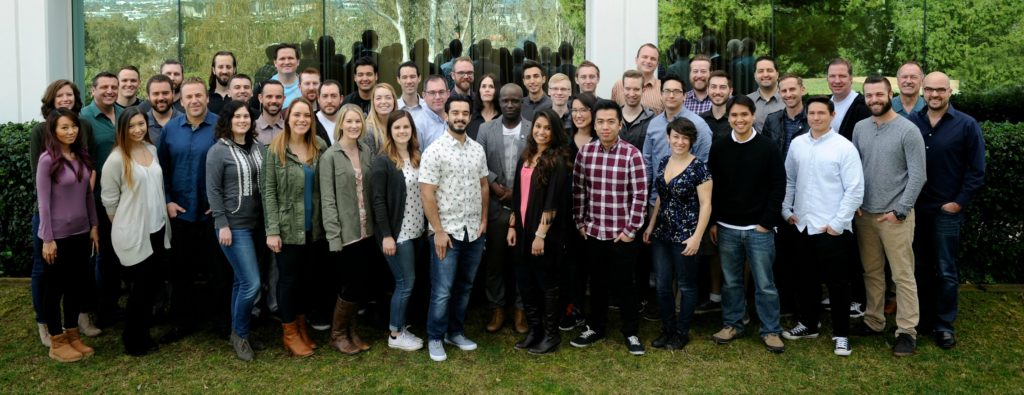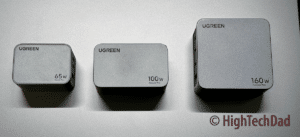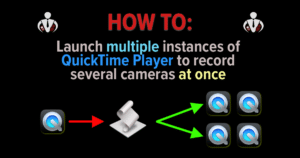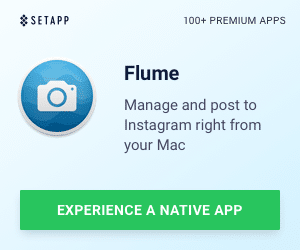I’m lucky. For over a decade I’ve been writing reviews and articles on my site on a variety of topics. From pieces on consumer electronics to How-To articles to content focused on software, hardware, social media, content marketing, and more, I’ve had pretty good access to some of the latest tech. It’s taken time to build my credibility but it has been well worth it.
The thing is, this took a lot of work and time, and sort of being a “first mover” in the “technology meets parenting” space. And while I get to test and keep a lot of gadgets (with full disclosure of course) for my articles, it does come with a lot of back-end work, research, testing, photography and/or video, and eventually, writing.
But I’m going to let you in on a secret.
There is a company that gives you access to tech to try out, often before it hits the market, and you don’t have to write a lengthy review or produce a video. You simply receive and test a piece of hardware or software, answer survey questions, submit bugs, maybe keep a journal, and have online discussions with other testers and the product’s company. And often, you get some kind of “reward” at the end!
Sounds great, right? Well, it is!
The name of the company is Betabound and you can become a tester quickly, easily, and for free.
So, what’s the catch? Honestly, apart from providing your feedback on a regular basis during a test, there really isn’t any. And what if you are a company with a product to test? There is that side of the equation as well, obviously. And I speak from experience having been on both sides: tester and company. Most of my experience, however, is on the testing side. I have tested a variety of things, hardware and software. But the testing is highly confidential in nature. You often can’t publicly discuss who the company is or what exactly you are testing. Many of the products are prototypes or haven’t been released yet. So, unfortunately, I can’t share the names of those companies.
Got your interest yet? If you are a technophile, gadget-lover, consumer electronics aficionado, software addict, or just want to help a company test their product, I would highly recommend signing up for Betabound. But let’s dive into what’s involved a bit more. And, I also had the chance to interview Brad Day, Betabound’s director, who provides some additional insights and answers to my questions about the company and the service they provide.
Signing up to be a Betabound tester
The most important part of being a Betabound tester is to make sure you have a full, accurate profile of who you are, what makes you tick, and what type of tech environment you have. The more detailed your profile, the more opportunities you will get. (And I recommend regularly revisiting and updating your profile as you add tech to your environment.)
If you want to follow along here, head over to the Betabound signup page!
Your Member Profile includes things like:
- Address (so they can send you things)
- Demographics (family info, home type, etc.)
- Education & Work Experience
- Experience (this one is interesting as it talks to the type of “geek” you are)
Once you finish your profile, I’d recommend spending time building out your Platforms. Here, you will specify details on the types of technology products you have. The general categories are:
- Game Console
- Home Theater
- Mobile Phone
- Personal Computer
- Smart Home
- Tablet
- Wearable
Within these categories, you will go into some of the specifics and details of these items. This will help companies potentially choose you for a test (or not). Doing this process does take a bit of time because for each item you add to a category, you have to supply a bunch of details. For example, under the Gaming Console category, I added my old Xbox 360. I then had to specify the following (and I have put in some of my information below to show you how the profile is built out):
- Type of Gamer – Casual
- Console Type – Xbox 360
- Xbox 360 Type – Slim
- Xbox Live Gold Subscription – No
- Xbox Live Gamer Tag – HighTechDad
- # of Controllers – 2
- Xbox Peripherals – Kinect
- Video Resolution – 1080p
- Audio Configuration – Surround
- Internet Connection – Wired
- Games Purchased Online – none
- Total Games Owned – 21-30
You get the picture. So, if you have a ton of gadgets, be prepared to spend some time entering the details. You can always go back and add more or update details later.
Frequently, there are some surveys that may go into additional criteria about who you are. And, there may be product surveys available. When I first signed up, I didn’t notice these, or perhaps some have been entered since I joined. Product Surveys are indeed that, surveys for a specific product or service. These are not generalized by category. These product surveys do require you to have used or own the specific product. As I wrote this article, I saw a bunch of products I WISH I had, but since I don’t own them, I couldn’t fill them out.
Lastly, another important section is the Testing Interests. This is where you specify the items that you would be interested in testing. It can have a pretty wide range of items, so really think about those items that you would be passionate about testing. In looking at the items I selected (Consumer Electronics, Entertainment, Home Automation, IT, Mobile Technology, Networking, Security, Storage, Telecommunications, Video, and Wearable Electronics), I realize that I have indeed gotten at least one offer to test in a majority of these aforementioned categories.
Getting a Betabound Project
So now the fun begins as you watch all of the offers to help test come rolling in! Well, honestly and to set the record straight, you aren’t bombarded with offers. They do come in, but it is not like getting instant messages. (This is actually a good thing because to do a good job testing, you really should only have a couple of tests going.)
Typically, you will receive an email with a mention about a product category, perhaps a “smart thermostat.” You can then apply to be a tester for that particular item and then fill out a survey. Be honest yet enthusiastic on your answers. The companies will evaluate how you respond and then select you (or not).
You can also browse the Betabound home page for active projects there, and if there is one that really looks great to you, you can apply to it. Below is a recent snapshot of the Betabound home page that shows some possible betas to apply to.
You can fine-tune what you see on the home page so that you only get items that appeal to you.
Once you apply, you just wait to hopefully get accepted.
Doing a Betabound Project
If you get accepted, congrats! Now the fun begins. It’s a bit difficult to say what exactly is involved in the testing simply because it depends on the product or service being tested. You may be shipped a device. You may be asked to install an app on your smartphone or your computer. It varies.
What is consistent is the Betabound platform. You will often be greeted with an introduction to the product and/or test. And quite frequently, you will be asked to agree to not disclosing information about the product, the company, or what you are testing (essentially, filling out a non-disclosure agreement – NDA).
The tests that I have done were broken out into time segments. You have a week to test XYZ. The first test could be just the installation or set-up process. You most likely will receive a survey so that the company can understand how that process went. Or you may be asked to follow particular steps or test a specific feature. With each of these, you will be asked to fill out a survey.
There is also a place to enter bugs or issues. This is an important part of the process. Providing feedback will only make the product better and more error-free. If you submit a bug, you may be asked for additional details.
There is also typically a place to provide feature suggestions or feedback. And there is typically a forum for you to discuss things with other testers as well as the company or the Betabound community managers.
Essentially, the entire process encourages discussion and feedback within an organized framework, making it easier for companies to understand what is or isn’t working with the product being tested.
Once the testing is complete, and it could be a short test of a week or two or longer, the project ends. Often, as a thank-you for your efforts, you are given some sort of a gift like an Amazon gift card. You might not, however, get to keep the product being tested. Unfortunately, I had to return a piece of hardware that I really liked and that I tested for quite a long time. But it was a prototype.
Still, doing these beta tests allows you to be on the cutting edge of tech and get a glimpse of things to come. It’s a lot of fun!
More Details about Betabound
 As I mentioned previously, I was able to interview Brad Day, Betabound’s director. Below are a series of questions I asked and Brad’s responses. These should help paint an even more detailed picture of Betabound and how it is helping companies produce better products, and letting consumers get early access to some of the latest and greatest tech.
As I mentioned previously, I was able to interview Brad Day, Betabound’s director. Below are a series of questions I asked and Brad’s responses. These should help paint an even more detailed picture of Betabound and how it is helping companies produce better products, and letting consumers get early access to some of the latest and greatest tech.
HighTechDad: How long has Betabound been in existence?
Brad Day: OnlineBeta (Betabound’s former alias) started shortly after Centercode was founded in 2001.
HighTechDad: What is the difference between Betabound and Centercode?
Brad Day: Centercode is the company behind Betabound. Betabound is an online community managed and supported by the Centercode team. Centercode is the software platform that Betabound runs on. The Centercode platform is an end-to-end Customer Validation platform designed to help companies collect and organize detailed feedback, manage users and build a tester panel, and ultimately manage full-on testing programs.
HighTechDad: Who founded Betabound and what was the idea behind it?
Brad: Betabound was originally OnlineBeta – an online community that testers signed up for to hear about beta testing opportunities. In February 2014, we transformed OnlineBeta into Betabound, and expanded upon the idea. Instead of being a community where you signed up and then waited to hear about opportunities, the site evolved into a much more active environment where users are able to see a feed (updated daily) of new testing opportunities available to them. The old functionality remains the same, of course – with the added benefits of having something to do from day 1.
HighTechDad: How many end users are there doing beta tests currently?
Brad: We can’t share specific numbers, but at any given time, we have thousands of testers actively participating in a Betabound project of some kind.
HighTechDad: How many companies are having their hardware/software tested?
Brad: We’ve worked with hundreds of companies over the years.
HighTechDad: What is the business model? I’m guessing that companies pay for access to the platform as well as user profiles?
Brad: Not quite! Centercode customers can purchase managed tests, in which they receive a fully dedicated Centercode project team devoted to their project. The core of this team is the Test Manager and the Tester Lead. The Test Manager is the primary point of contact for the client throughout the project and is ultimately responsible for the project’s success. The Tester Lead is the primary point of contact for the testers, responding to their feedback and actively encouraging participation throughout the test.
A typical managed test looks something like this: A multiple week test in which we guarantee that you will have X number of people from your target market actively testing and using your product. The Centercode team handles everything from start to finish – all the way from recruiting testers at the beginning to delivering feedback and survey reports at the end.
Additionally, we license the Centercode platform to companies looking to manage their own testing programs in-house.
HighTechDad: What are the features of the testing platform? I have seen things like Bug Reports, Discussions, Polls, Journals, Suggestions, etc. What other things are available?
Brad: On the front-end, those are the majority of the features available. The admin side offers a much wider feature set. The platform is designed to help admins recruit and profile testers, manage projects within their program, deliver insights via a built-in reporting engine, and more. This barely scratches the surface in terms of features available within the platform. This page does a much better job of describing it :)
HighTechDad: What are some of the craziest things what were tested?
Brad: I wouldn’t classify any of them as “crazy” – but we’ve tested a super wide variety of products. We’ve tested unique products like wearable devices designed for infants and other, more conventional products like smart thermostats – you never really know what’s coming next.
HighTechDad: Do companies let testers keep the products they test?
Brad: Sometimes! It depends on the particular test. In some cases, the product is a suitable incentive at the end of the test. In other cases, the company developing the product may ask for the products to be returned, at which point we’ll provide gift cards or some other form of incentive to thank testers for participating. That being said, keeping the product should never be an expectation when participating in a Betabound project.
HighTechDad: Why would someone want to be a tester?
Brad: Good question! We actually ran a survey that asked this question, and the most popular response was “To help improve the products I already use”. This was a super cool thing to see – that the majority of our community was interested in testing because they shared our vision, to help make technology a better thing globally.
We’re consistently impressed by the determination and effort that Betabounders put into the projects that they’re engaged with. Testers are not employees – they’re all at-will volunteers. As such, hearing from them directly about their motivation and then realizing that their motivation was in-line with ours was an amazing moment for us.
HighTechDad: Why would a company want to use the Betabound platform?
Brad: It’s immensely valuable to collect feedback from your target market before launching your product. By putting your product in the hands of your target market (meaning they’re people who likely would purchase your product if it were released), you’re simulating an experience similar to if that user had just purchased the product at a store. Their feedback is hugely valuable and can influence the direction you take your product.
We’ve seen companies develop entirely new features that their product was missing because it was something they hadn’t considered during development, but was heavily requested once the product was in the hands of their target market. It’s much better to get ahead of these kinds of things and tackle them before your product is launched to the public. That way, you can head into day one of your launch knowing that your product is fine-tuned to be what your customers want it to be. Centercode acts as a medium to help companies achieve these goals. We want to help make technology a better thing across the entire world – by working with companies to help them thoroughly test their products with their target markets, we’re playing a critical part in that movement.
HighTechDad: How many people work at the company?
Brad: Centercode currently has ~60 employees.
HighTechDad: How many Betabound employees are typically assigned to a program and what is their role?
Brad: A typical Betabound project sees only a few Centercode employees assigned to it. There are a few internal roles involved in the setup of the project, but as far as boots on the ground once the project gets started – the majority of the work is handled by the Test Manager and the Tester Lead. The Test Manager manages the project and ensures everything keeps rolling smoothly, while the Tester Lead is actively engaged with testers, going back and forth with them on issues and encouraging participation.
HighTechDad: How are testers chosen?
Brad: Tester selection is a complex process with a lot of moving parts. We try to ensure that the tester pool on each test has testers who have participated in a project before (and are thus familiar with the process) and those who haven’t, to give them a shot to prove themselves. Each private test has a set of requirements that all testers have to meet in order to participate. Furthermore, we typically have segmentations that break up the tester pool – things like 50% Android users / 50% iOS users.
Ultimately, what we’re looking for are users that are enthusiastic about the product that is being tested. Testers who are well-spoken and seem like they truly care about the opportunity that they’re applying for have a better shot of being picked (compared to applicants who type in ALL CAPS and are only signing up because they want to potentially receive the product for free)
HighTechDad: What are the types of products that are tested?
Brad: Anything and everything – we’ve tested products that range from personal finance apps to smart fitness wearables to home entertainment devices. There’s a huge variety in the types of products that get tested through Betabound, which is part of why it’s so exciting! You never really know what opportunity is coming next.
So that’s the scoop! When you think about it, Betabound is helpful to both the consumer and the company. For one, those lucky Betabound testers get to try out the cutting edge of technology. And, as a result of their testing, the products are better in the long run. All too often, when companies test their own products, they get numb to some aspects of it. So, by providing a third-party perspective, they get to have testing done that they wouldn’t have come up with themselves. It’s a win-win across the board!
If this interests you at all, I encourage you to become a Betabound tester. And heck, tell them that HighTechDad sent you!
Disclosure Text: I have a material connection because I received monetary compensation for consideration in preparing to review the product/service and write this content. All opinions within this article are my own and are typically not subject to the editorial review from any 3rd party. More information can be found on my About page.
HTD says: Getting to test hardware, software, or services before everyone else is really fun, especially if down the line you can brag that you helped bring it to market as something even better. Betabound helps you do just that! So, sign up and get testing!

